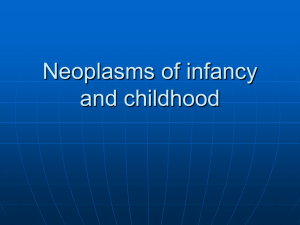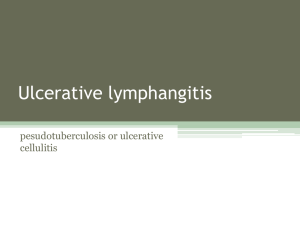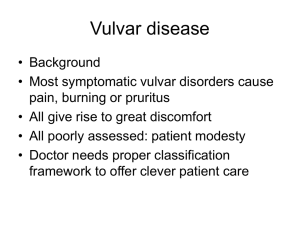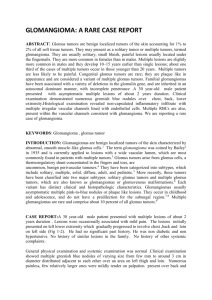Chapter-39-Soft-Tissue-Tumours
advertisement
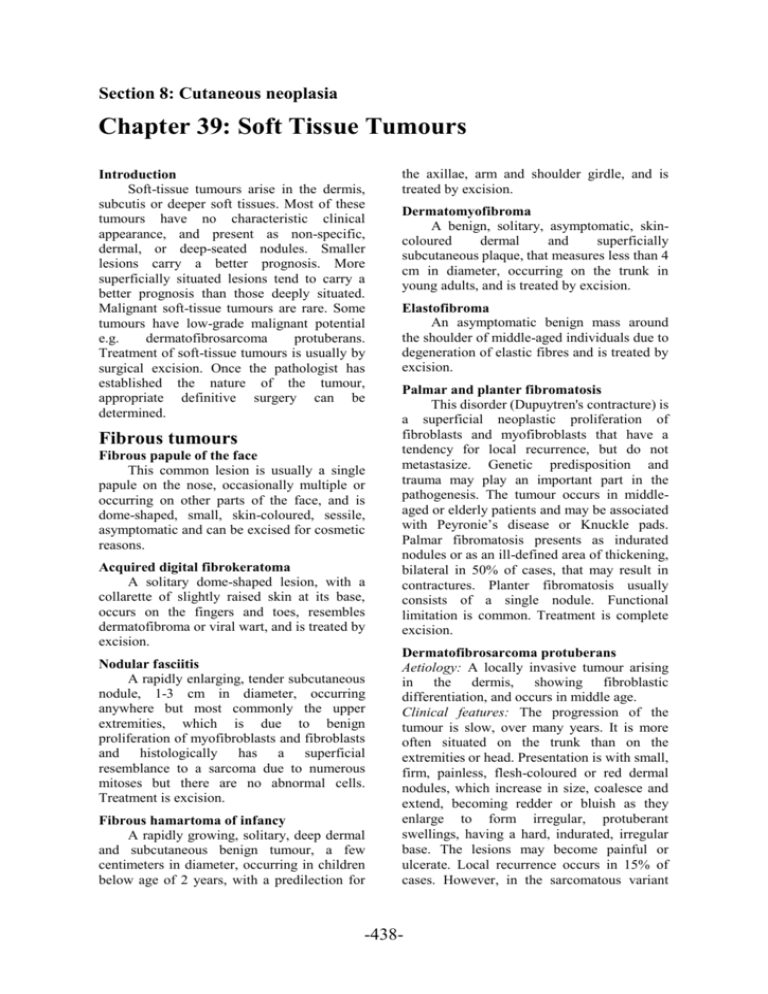
Section 8: Cutaneous neoplasia Chapter 39: Soft Tissue Tumours Introduction Soft-tissue tumours arise in the dermis, subcutis or deeper soft tissues. Most of these tumours have no characteristic clinical appearance, and present as non-specific, dermal, or deep-seated nodules. Smaller lesions carry a better prognosis. More superficially situated lesions tend to carry a better prognosis than those deeply situated. Malignant soft-tissue tumours are rare. Some tumours have low-grade malignant potential e.g. dermatofibrosarcoma protuberans. Treatment of soft-tissue tumours is usually by surgical excision. Once the pathologist has established the nature of the tumour, appropriate definitive surgery can be determined. Fibrous tumours Fibrous papule of the face This common lesion is usually a single papule on the nose, occasionally multiple or occurring on other parts of the face, and is dome-shaped, small, skin-coloured, sessile, asymptomatic and can be excised for cosmetic reasons. Acquired digital fibrokeratoma A solitary dome-shaped lesion, with a collarette of slightly raised skin at its base, occurs on the fingers and toes, resembles dermatofibroma or viral wart, and is treated by excision. Nodular fasciitis A rapidly enlarging, tender subcutaneous nodule, 1-3 cm in diameter, occurring anywhere but most commonly the upper extremities, which is due to benign proliferation of myofibroblasts and fibroblasts and histologically has a superficial resemblance to a sarcoma due to numerous mitoses but there are no abnormal cells. Treatment is excision. Fibrous hamartoma of infancy A rapidly growing, solitary, deep dermal and subcutaneous benign tumour, a few centimeters in diameter, occurring in children below age of 2 years, with a predilection for the axillae, arm and shoulder girdle, and is treated by excision. Dermatomyofibroma A benign, solitary, asymptomatic, skincoloured dermal and superficially subcutaneous plaque, that measures less than 4 cm in diameter, occurring on the trunk in young adults, and is treated by excision. Elastofibroma An asymptomatic benign mass around the shoulder of middle-aged individuals due to degeneration of elastic fibres and is treated by excision. Palmar and planter fibromatosis This disorder (Dupuytren's contracture) is a superficial neoplastic proliferation of fibroblasts and myofibroblasts that have a tendency for local recurrence, but do not metastasize. Genetic predisposition and trauma may play an important part in the pathogenesis. The tumour occurs in middleaged or elderly patients and may be associated with Peyronie’s disease or Knuckle pads. Palmar fibromatosis presents as indurated nodules or as an ill-defined area of thickening, bilateral in 50% of cases, that may result in contractures. Planter fibromatosis usually consists of a single nodule. Functional limitation is common. Treatment is complete excision. Dermatofibrosarcoma protuberans Aetiology: A locally invasive tumour arising in the dermis, showing fibroblastic differentiation, and occurs in middle age. Clinical features: The progression of the tumour is slow, over many years. It is more often situated on the trunk than on the extremities or head. Presentation is with small, firm, painless, flesh-coloured or red dermal nodules, which increase in size, coalesce and extend, becoming redder or bluish as they enlarge to form irregular, protuberant swellings, having a hard, indurated, irregular base. The lesions may become painful or ulcerate. Local recurrence occurs in 15% of cases. However, in the sarcomatous variant -438- recurrence is 75% and metastases occur in 20%. Pathology: The dermis and subcutaneous tissue are replaced by bundles of uniform spindle-shaped cells with little cytoplasm and elongated hyperchromatic, but not pleomorphic, nuclei. Usually there is little mitotic activity. Laterally, the tumour cells infiltrate widely between collagen bundles of the deeper dermis and blend into the normal dermis, forming quite definite bands, which interweave or radiate like spokes of a wheel; this is described as a ‘storiform’ pattern. The subcutaneous tissue is extensively infiltrated. In the fibrosarcomatous variant, mitoses are increased and there is more nuclear hyperchromatism. Treatment: The tumour should be excised completely, with a generous margin of healthy tissue as local recurrence invariably follows inadequate removal. Fibrohistiocytic tumours Fibrous histiocytoma This disorder (dermatofibroma, FH) is a benign dermal and often superficial subcutaneous proliferation of oval cells resembling histiocytes, and spindle-shaped cells resembling fibroblasts and myofibroblasts. It is most common on the limbs and presents as a firm, yellow brown, slightly scaly papule. If the overlying epidermis is squeezed the ‘dimple sign’ will be seen, indicating tethering of the overlying epidermis to the underlying lesion. Giant lesions (more than 5 cm in diameter) are occasionally seen. Clinical variants include cellular FH, aneurysmal FH, atypical FH and epithelioid FH. The pathology shows epidermal hyperplasia. In the dermis, there is a localized proliferation of histiocyte-like and fibroblastlike cells, associated with a variable number of mononuclear inflammatory cells. Foamy macrophages, siderophages and multinucleated giant cells are also variably present. A focal storiform pattern is often seen. Collagen bundles at the periphery of the lesion are surrounded by scattered tumour cells and appear somewhat hyalinized. Histopathological variants exist including cellular FH, aneurysmal FH, atypical FH and epithelioid FH. Most FHs are of cosmetic importance only and no treatment is necessary. However, cellular, aneurysmal and atypical variants should be completely removed, because of the risk of local recurrence. Vascular tumours Reactive angioendotheliomatosis A reactive vascular proliferation, which is usually multifocal and which is associated with a number of systemic diseases including bacterial endocarditis, peripheral vascular atherosclerotic disease, cryoglobulinaemia, antiphospholipid syndrome, amyloidosis and liver and renal disease. Most patients present with multiple erythematous and/or haemorrhagic macules, papules and plaques on the trunk and limbs. The dermis shows a multifocal proliferation of clusters of capillaries lined by plump endothelial cells. The condition usually resolves spontaneously within a few weeks. Pyogenic granuloma Aetiology: This disorder (granuloma telangiectaticum) is common, occurs at any age and is probably a reactive lesion. A vascular nodule develops rapidly, often at the site of a recent injury, and is composed of a lobular proliferation of capillaries in a loose stroma. Pathology: The endothelial cells are plump, as in new granulation tissue, lining the vessels in a single layer. The proliferating vessels are set in a myxoid stroma rich in mucin. There is a mixed cell population of fibroblasts, mast cells, lymphocytes and plasma cells. Mitotic figures may be prominent. Older lesions tend to organize and partly fibrose. Clinical features: The tumour is vascular, bright red or blue-black, rounded, 5-10 mm up to 50 mm in diameter, compressible, the base is often pedunculated and surrounded by a collar of epidermis, and the surface may b eroded and it bleeds easily. Treatment: By curettage with cauterization or diathermy coagulation of the base. Other treatment modalities that have been used include topical imiquimod 5% cream, cryosurgery, Nd: YAG laser, flash lamp pulsed dye laser, intralesional steroids and even injection of absolute ethanol. Epithelioid haemangioma This disorder (angiolymphoid hyperplasia with eosinophilia, pseudopyogenic granuloma) is a benign locally proliferative lesion composed of -439- vascular channels lined by endothelial cells having abundant pink cytoplasm and vesicular nuclei, associated with an inflammatory infiltrate composed mainly of lymphocytes and large numbers of eosinophils. Affected individuals are commonly young adults, who present with a cluster of small, translucent nodules on the head and neck, particularly around the ear or the hairline. Spontaneous remission occurs in the majority of cases. Peripheral blood eosinophilia occurs in 10% of cases. It is reasonable to observe the lesion for 3-6 months and await spontaneous regression. Both surgery and radiotherapy are effective, but local recurrences are common. Kaposi’s sarcoma (KS) Definition: KS is a multifocal endothelial proliferation predominantly involving the skin and other organs and associated with formation of vascular channels and proliferation of spindle-shaped cells. It is induced by herpesvirus HHV8 which is present in all KS patients. This virus, along with genetic, environmental and immunological factors is closely involved in the pathogenesis of KS. The disease starts as a reactive angioproliferative and inflammatory process but progresses to become a neoplastic process. The proliferating cells are endothelial cells with lymphatic differentiation. There are 4 clinical types of KS: classic, endemic, iatrogenic and HIV-related. Classic KS: Occurs in elderly males and the lesions begin slowly and insidiously around the ankle and slowly spread up the leg. Lymphoedema can occur as a complication. Involvement of internal organs and death from the disease is not usually seen. Endemic KS: Occurs in equatorial Africa, predominantly in adult males, but children can be affected. Crops of cutaneous vascular lesions develop and may be associated with gross oedema. Visceral lesions may occur leading to a poor prognosis. The condition responds to chemotherapy. Iatrogenic KS: Occurs in transplant patients and after cytotoxic chemotherapy for lymphomas. Both systemic and cutaneous lesions may occur and the progress may be aggressive leading to death. If it is possible to remove the immunosuppression, the lesions will regress. KS associated with HIV infection: This is much commoner in homosexuals than in drug abusers. It usually develops in the later stages of the disease. The lesions may occur anywhere on the body with explosive rapidity and become large nodules. Involvement of lymph nodes, lungs and GIT is common. Both radiotherapy and chemotherapy give temporary benefit and the prognosis is poor. Pathology: The skin lesions can be divided into patch, plaque and nodular stages. In the patch stage there is proliferation of irregular, lymphatic-like vascular channels lined by a single layer of endothelial cells, surrounding normal pre-existing capillaries and adnexal structures, which seem to be floating within the newly formed channels, the so-called ‘promontory sign’. A patchy inflammatory mononuclear cell infiltrate containing plasma cells is seen. This is associated with extravasation of red blood cells and haemosiderin deposition. The plaque stage is an exaggeration of the patch stage. The vascular channels increase in number and a network of spindleshaped cells with pink cytoplasm develops. Eosinophilic globules are common, and probably represent degenerate red blood cells. Involvement of the whole dermis and superficial subcutis is frequent. In the nodular stage, there are fairly wellcircumscribed nodules of spindle-shaped cells forming frequent cleft-like spaces that impart a typical sieve-like appearance. Extravasated RBCs are plentiful, as are hyaline globules. Mitotic figures are common. A useful aid in the histological diagnosis of KS is monoclonal antibody against HHV8, which stains tumour cells in all cases of the disease. Clinical features: KS tends to occur in males. The lesions have a dark-blue or purplish colour. Initially they may be macular and when they become tumid, pressure may produce partial blanching to reveal a brown tinge. The process usually bengins on the extremities, most commonly on the feet, and occasionally on the hands, ears or nose. Individual tumors enlarge to a diameter of 1-3 cm and stop growing. The process is multifocal, and adjacent areas may fuse to form a plaque or tumour. Oedema of the limb may occur and nodules on pressure areas may be painful. The rate of spread is remarkably variable. The lesions may involute to leave pigmented scars, or may become eroded, ulcerated or fungating. Lymph nodes, mucosal surfaces and internal organs, may be involved -440- as the disease progresses. KS may occur in internal organs without skin manifestations. In KS due to immunosuppression, there may be only one or 2 lesions scattered over the body. Differential diagnosis: The evolution of KS from a macular lesion and its characteristic colour, slow development and multifocal distribution makes the diagnosis likely in most cases. Pseudo-Kaposi’s sarcoma (acroangiodermatitis) occurs in prolonged venous stasis of the lower legs, lack progression and spindle-cell proliferation. Treatment: Where a small area is involved, excision or radiotherapy can be used. Superficial radiotherapy is rapid and effective, and is the treatment of choice for the majority of patients with nodular disease of the extremities. Extensive disease can be treated by cytotoxic drugs such as chlorambucil, cyclophosphamide, vinblastine or actinomycin. Cases related to AIDS may respond to intralesional vinblastine or vincristine, IL-2 or interferon. Pegylated liposomal doxorubicin is a successful treatment of advanced classic KS and cases associated with AIDS. Angiosarcoma Definition: A malignant vascular tumour, arising from both vascular and lymphatic endothelium. It occurs in 3 settings: idiopathic angiosarcoma of the face, scalp and neck, angiosarcoma associated with chronic lymphoedema (Stewart-Treves syndrome) and post-irradiation angiosarcoma. Stewart-Treves syndrome occurs in 5% of patients who survive mastectomy for more than 5 years. Pathology: Vascular channels infiltrate the normal structures in a disorganized fashion. They are thin-walled, irregular and are lined by atypical endothelial cells which form solid intravascular buds. Haemorrhage is often prominent. Immunohistochemical studies have indicated that the antibodies to CD31 are the most reliable markers. Clinical features: In all types of angiosarcoma the first sign may be an area of bruising. Dusky blue or red nodules develop and grow rapidly, and fresh discrete nodules appear nearby. In some cases, haemorrhagic blisters are a prominent feature. As the tumours grow, the oedema may increase and older lesions may ulcerate. Multifocality is very frequent. Dissemination occurs early, with the first visceral deposits usually being in the lung and pleural cavity. The 5-year survival is about 12%. Treatment: All angiosarcomas have a bad prognosis. Wide excision and grafting has controlled some cases. The response to radiotherapy is disappointing and is usually only palliative. Tumours of perivascular cells Glomus tumour Definition: A tumour of the myoarterial glomus composed of vascular channels surrounded by proliferating glomus cells. The tumour has variable quantities of glomus cells, blood vessels and smooth muscle. According to this finding, they are classified as solid glomus tumour, glomangioma and glomangiomyoma. Pathology: The tumour is round wellcircumscribed and situated in the dermis. The proportion of glomus cells to vascular spaces varies. The smaller, painful lesions tend to be mainly cellular (solid glomus tumour, in 35% of cases). The larger, multiple and often painless lesions are angiomatous (glomangiomas, in 50% of cases), with only a band of cells around the dilated vascular channels. Glomangiomyomas are a minority (15%). The glomus cells are cuboidal, with a well-marked cell membrane and a round central nucleus. The cells align themselves in rows around the single layer of endothelial cells of the vascular spaces. Numerous nonmyelinated nerve fibres course through the cellular masses. Clinical features: A solitary glomus tumour is a pink or purple nodule varying in size from 1 to 20 mm and is conspicuously painful. Pain may be provoked by direct pressure or a change in skin temperature, or may be spontaneous. The commonest site is the hands, particularly the fingers, followed by the extremities, head, neck and penis. Tumours beneath the nail are particularly painful and the nail has a bluish-red flush. Multiple glomus tumours are larger and usually dark blue in colour, and are situated deep in the dermis. They may be widely scattered and are not usually painful. Treatment: Surgical excision is usually curative. -441- Neural tumours Tumours of smooth muscle Schwannoma Definition: A tumour of nerve sheaths composed of Schwann cells. It arises most frequently from the acoustic nerve. Bilateral acoustic Schwannomas are characteristic of neurofibromatosis type 2. In the peripheral nervous system, it is usually found in association with one of the main nerves of the limbs. Pathology: The tumour is rounded, circumscribed and encapsulated. It is situated in the course of a nerve, usually in the subcutaneous fat. The cells are spindle shaped with a poorly defined cytoplasm and elongated wavy basophilic nuclei. Variable amounts of collagen are seen in the background. Cells are arranged in bands, and their nuclei are arranged in rows with intervening eosinophilic cytoplasm in a typical appearance known as verocay bodies. There are several histopathological types which include ancient, cellular, plexiform, melanotic, pacinian and glandular Schwannomas. Clinical features: Lesions are nodules: rounded or oval, firm, grow slowly, circumscribed, up to 5 cm size, pink-grey or yellowish, small lesions may be intradermal but larger ones are subcutaneous. Deferential diagnosis: Of the various nodular dermal and hypodermal tumours, Schwannoma is most likely to be mistaken for a glomus tumor when painful, and for lipoma, epidermoid cyst, juxta-articular node or neurofibroma when asymptomatic. The diagnosis is suspected when it is in the course of a nerve. Treatment: Surgical excision. Leiomyoma There are 3 clinical types of leiomyoma: Pilar, genital and angioleiomyoma. Pilar leiomyoma (leiomyoma cutis) originates in the pilomotor muscle, is the most frequent type and occurs at any age. It presents as a collection of multiple, pink, red or dusky brown, firm dermal nodules of varying size but usually less than 15 mm diameter. The nodules most commonly occur on the extremities and may evolve to form a plaque. The nodules are often subject to episodes of pain provoked by touch or cold, and may be tender. The lesions may contract and become paler when painful. Genital leiomyoma is a solitary dermal nodule arising in the smooth muscle of the genitalia (scrotum, penis, labia majora) and areola of the nipple and occurs at any age. Scrotal tumours are often large. Pain is less frequent than with leiomyoma cutis and contraction in response to stimulation by touch or cold can occur. Angioleiomyoma is a solitary, fleshcoloured, rounded, subcutaneous or deep dermal tumour, arising from the muscular coat of veins, occurring in middle age, usually on a limb. Diameter is up to 40 mm and it is painful in 50% of cases, pain being triggered by cold, pregnancy or menses. Leiomyoma is a benign tumour of smooth muscle and the pathology shows smooth muscle cells proliferating to produce interweaving bundles of spindle-shaped cells, which are strongly eosinophilic, having long and thin nuclei. Multiple cutaneous leiomyomas is composed of numerous dermal nodules which show epidermal hyperplasia. Genital leiomyomas are nodular tumours with a similar appearance. The angiomyomas are related to veins in the subcutaneous tissue, showing vessels of variable thickness intermixed with bundles of mature smooth cells. The solitary painful lesion may be mistaken for a glomus tumour or an eccrine spiradenoma, and the history of contraction on cold exposure is helpful in diagnosis. Surgical excision cures the solitary tumour, but extensive lesions require plastic surgery. Medical treatment that may relieve pain include calcium-channel blockers and gabapentin. Plexiform neurofibroma This tumour is pathognomonic for neurofibromatosis type 1. It presents in children and young adults with predilection for the lower limbs and the head and neck. Tumours are large and located in the dermis, subcutis and deeper soft tissues. The overlying skin is folded and hyperpigmented and the lesion is described as having the appearance of a ‘bag of worms’. Surgical removal is usually very difficult due to tendency for haemorrhage. -442-


